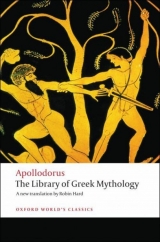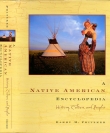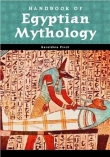
Текст книги "The Library of Greek Mythology"
Автор книги: Apollodorus
Жанры:
Религия
,сообщить о нарушении
Текущая страница: 15 (всего у книги 27 страниц)
Ouranos. . . Ge: respectively the Sky and the Earth (who was also referred to as Gaia, the form preferred by Hesiod). For the early history of the universe, cf. Theog. 116 ff., but the present account sometimes diverges significantly (perhaps following a theogony from the epic cycle, summarized by Proclus in Photius 319A). In Theog., Chaos—representing a yawning gap rather than disorder– comes into being first, followed by Gaia, Tartaros, and Eros (116 ff.), and Gaia gives birth to Ouranos from herself (126 f.).
the Cyclopes: cf. Theog. 139 ff.; named the ‘Round-Eyed’ because of their single round eye. Their individual names were suggested by their prime function, as the beings who armed Zeus with his thunder (see p. 28): (a)steropemeans lightning, bronte, thunder, and argesrefers to the brightness associated with the thunderbolt. For other kinds of Cyclops, see p. 63 and note and pp. 164 f.
in Hades: here used in a loose sense to refer to the Underworld as a whole. In the early tradition at least, a clear distinction was drawn between Hades (where the souls of dead mortals dwell) and Tartaros, a dungeon for gods and monsters that lay far beneath it (cf. Theog. 720–819, Il;. 8. 13 ff.).
who had been thrown into Tartaros: only the Cyclopes and Hundred-Handers; Hesiod’s account, in which Ouranos also hides away their Titan children (Theog. 154 ff), diverges significantly.
adamantine: made of adamant, a mythical metal of extreme hardness.
from the drops of blood that flowed out: from those that fell on Ge, the Earth, causing her to conceive the Furies, and the Giants whom she will bring to birth later (p. 34); cf. Theog. 183 ff. (In Ap.’s theogony the severed genitals play no part in the birth of Aphrodite, see p. 29 and note.)
Mount Dicte: in most sources Mount Ida, in Theog. 484, Aigaion; Dicte only in Hellenistic and later sources, e.g. AR 1. 509. Although Dicte was associated with the cult of Zeus, there was no cave there.
Curetes: Cretan semi-divinities associated with fertility; estimates of their number vary from two to ten.
Amaltheia: either a nymph with a she-goat (see p. 89 and note) or the goat itself, as here (cf. Callim. Hymn1. 47 f).
Metis: personifies practical or cunning intelligence. In Theog. 494 ff., where the stratagem is not explained, the advice is offered by Gaia.
a helmet: this leather helmet or cap makes its wearer invisible. It will be used by Perseus, see pp. 65 f. and note. In Theog. 501 ff. the Cyclopes arm Zeus alone, in gratitude for their release.
they shared power: following Il. 15. 187 ff.
Pluto over the halls of Hades: Pluto, ‘the Wealthy One’, was a ritual title for Hades, god of the Underworld; his name is also applied to his realm (although in classical Greek a genitive form was used in such cases, to indicate that the ‘halls of Hades were being referred to rather than the god himself).
Oceanides: the daughters of Oceanos and Tethys, who were nymphs of springs and groves. Hes. names forty-one of the ‘eldest’ daughters (Theog. 346 ff), but remarks that there were three thousand (364); Ap. only gives the names of those who will be mentioned in the following genealogies. For Hesiod, Amphitrite was a Nereid (243). The sons of Oceanos and Tethys were the rivers of the earth (337 ff). Theog. should be consulted for further details on all these divine genealogies (although Ap. sometimes chooses variants from other sources).
Nice, Cratos, Zelos, and Bia: abstractions signifying Victory, Power, Emulation, and Force (all needed by Zeus for his victory against the Titans). See Theog. 383 ff.
oaths: specifically the oaths of the gods.
Pontos: a personification of the Sea. Ap. offers no genealogy; in Theog. 132 ff. he is borne by Gaia without prior intercourse. An ancestor of marine beings, and also of monstrous beings not easily associable with Zeus’ immediate family, see Theog. 233–336.
Nereids: beautiful sea nymphs, usually said to be fifty in number, who lived with their father in a cave at the bottom of the sea ( Il. 18. 37 ff., Theog. 240 ff.). Most of their names were suggested by aspects of the sea.
Hebe, Eileithuia, and Ares: respectively, the personification of youth (who performed household duties for the gods, notably as cupbearer, and later married Heracles, p. 91), the goddess of childbirth, and the god of war. For the genealogies in 3. 1 to 4. 6, cf. Theog. 886–933.
Eirene, Eunomia, and Dice: the Horai, Seasons, were associated with the seasons of growth in particular; these Hesiodic names (Theog. 901 f.)—Peace, Good Order, and Justice—point to the social conditions favouring successful agriculture.
by Dione he had Aphrodite: as in Il. 5. 370 f.; but in Theog. 188 ff. Aphrodite grows from the sea-foam (aphros)that surrounds the severed genitals of Ouranos when they are cast into the sea. Described above as a Titanid (but in Theog. 353, a daughter of Oceanos and Tethys), Dione was honoured at Dodona as the consort of Zeus, but otherwise she was of little importance in either cult or myth.
by Styx, Persephone: the river encircling Hades is a suitable mother for a goddess closely associated with the Underworld; but Persephone is usually regarded as Zeus’ daughter by Demeter, as in Theog. 912 f. and HH to Demeter2–3 (and below on p. 33).
Linos: see p. 71, a musician like his brother Orpheus.
persuaded Pluto: he is said to have enchanted Persephone and/or Pluto with his singing (DS 4. 25. 4, Conon 45).
Maenads: women possessed by Bacchic frenzy (see pp. 102 f.); in most accounts they are angered by the scorn that Orpheus showed for other women after he had lost Eurydice, e.g. Ov. Met. 11. 1 ff.
Cleio . . . Adonis: when Cleio mocked Aphrodite for falling in love with a mortal, Aphrodite caused her to become subject to a similar passion. Love for a mortal was acceptable for gods, but considered demeaning for goddesses (see Calypso’s observations in Od. 5. 118 ff).
the first man to love other males: Laios, p. 104, and Minos, p. 97, are other contenders for this title.
But Hyacinthos. . . a discus: it was sometimes said that the West (or North) Wind also sought his favour, and when he favoured Apollo, blew the discus at Apollo’s head (Lucian Dialogues of the Gods14; see also P. 3. 19. 5, Ov. Met. 10. 162 ff.). Traditions vary on his birth, see also p. 119.
challenged the Muses: cf. Il. 2. 594 ff.
Rhesos. . . at Troy: see Il. 10. 435 ff. and [Eur.] Rhesos.
Corybantes: semi-divine beings who attended deities with orgiastic rites, associated primarily with the Phrygian goddess Cybele, but also with Rhea and Dionysos.
Hera . . . by Zeus: Hera calls him a son of Zeus in Il. 14. 338 f; but in Hesiod’s account, Theog. 924 ff, Hera is so angered when Zeus gives birth to Athene from his head that she decides to have a child of her own without prior intercourse with her spouse, and gives birth to Hephaistos.
Zeus threw him down . . . to his rescue: in Il. 1. 590 ff, Hephaistos is said to have been thrown from heaven by Zeus for coming to the aid of Hera (for her suspension, see Il. 5. 18 ff), but in Il. 18. 394 ff, by Hera, because she was ashamed of his lameness; in the latter account he was rescued by Thetis and Eurynome, daughter of Oceanos, and taken to the cave of the Nereids beneath the sea.
Ge: inserted by Heyne; without this addition, the text would indicate that Metis herself gave the warning (placing her own safety at grave risk). Ge is the prime oracle in early mythical history. In Theog. 886 ff, Zeus takes this action on the advice of Ge and Ouranos.
near the River Triton: see p. 123 and note.
a city. . . called Delos: i.e. the island of Delos; its previous name is also given as Ortygia, after ortyx, a quail (e.g. Hyg. 140). In Pind. Paean5. 42 (cf. Callimachus Hymn4. 36–8), the holy island on which her sister Leto will give birth to Artemis and Apollo is formed from Asteria’s metamorphosed body.
Themis: a personification of law and the right; on the presiding figures at Delphi before Apollo, see also Aesch. Eumenides1 ff. and P. 10. 5. 3.
chasm: said to be the source of exhalations which inspired the Delphic priestesses to prophecy, although there is no sign of such a chasm on the modern site.
Pytho: Delphi.
Tityos suffers punishment: cf. Od. 11. 576 ff. On his death, cf. Pind. Pyth. 4. 90 ff.
disfigured her face: according to Hyg. 165, Hera and Aphrodite made fun of her when she played her flute at a banquet of the gods because it puffed her cheeks out, which she found to be true when she viewed herself in a spring on Mount Ida.
to do the same: as a wind instrument, his flute must be blown from the right end. On Marsyas, a Phrygian, see also Hdt. 7. 26.
blinded him: according to the fuller story in Parthen. 20 and Catast. 32, Orion cleared the island of wild beasts, but when Oinopion was reluctant to accept such a being as his son-in-law, he became impatient and raped Merope while he was drunk. This would explain Oinopion’s extreme behaviour.
of Hephaistos: added by Heyne (but Ap. may have assumed that the reader would understand that without explicit statement). It lay on Lemnos; Orion could find his way there by following the sound. In Catast. 32 Hephaistos takes pity on him and offers him one of his helpers, Cedalion, as a guide.
with Ares: Aphrodite’s lover, hence her anger.
shot by Artemis: in Od. 5. 121 ff. Artemis killed him because she and the other gods were angry that Dawn had fallen in love with a mortal. The later tradition is complex, but it was commonly said that he tried to rape Artemis herself, and that Artemis either shot him (Hyg. PA34, referring to Callimachus) or sent a scorpion against him (Aratus 635 ff. with sc. to 636, thus explaining the origin of the two constellations); or Ge sent the scorpion because he boasted that he would kill all the beasts on earth (Catast. 32).
Opis: Opis (or Upis), and Arge, another representative of this legendary northern race, came to Delos after the birth of Artemis and Apollo bringing a thank-offering, which had been vowed to Eileithuia, the goddess of childbirth, in return for an easy labour for Leto, see Hdt. 4. 35.
Rhode: a personification of the island of Rhodes, where there was a notable cult of the Sun; also as Rhodos (again a feminine form). See Pind. ol. 7. 54 ff.
abducted her: see Ap.’s main source, the Homeric Hymn to Demeter, for further details on all the following. There (16 ff.) she is abducted from the Nysian plain (of uncertain location; but in later writers, from Sicily, a land famed for its fertility). The abduction is in accordance with the plans of Zeus, but he plays no active part in it (ibid. 9; 30; and 77 ff.).
bearing torches: these played a significant role in the ritual associated with the Eleusinian Mysteries, and were emblematic of Demeter and her rites (ibid. 48).
Hermion: not in the Hymn, but appropriate because there was said to be a chasm there that communicated with the Underworld (P. 2. 35. 7).
Thesmophoria: an autumn festival celebrated by women in honour of Demeter to ensure fertility of the crops. The jokes were of an obscene nature.
Praxithea: presumably Demophon’s nurse. In the Hymn(242 ff.) Metaneira keeps watch, and the child is not killed; Demeter merely places him on the ground and renounces her plan to make him immortal.
revealed her identity: and promised to teach the Eleusinians her rites (HH Dem. 273–4), which ensured the initiates a better lot in the afterlife.
she gave him wheat: knowledge of agriculture was revealed by Demeter at Eleusis and spread by Triptolemos throughout the inhabited world; a favourite theme in Athenian propaganda.
Kore: ‘the Maiden’, a cultic title for Persephone as worshipped in conjunction with her mother.
a pomegranate seed to eat: a visitor who takes food in the other world is obliged to stay there. Pomegranates were associated with blood and death.
Ascalaphos. . . bore witness against her: not in the Hymn, where Persephone herself tells Demeter that she has eaten in Hades (411 ff.) and the consequences follow necessarily from the action. On Ascalaphos see further p. 84 and note.
a third of every year: cf. HH Dem. 398 ff. The agricultural significance is evident: she departs in autumn and returns in spring. In later sources the year is commonly divided into equal parts (e.g. Hyg. 146, Ov. Met. 5. 564 ff.).
conceived by Ouranos: from the blood that dripped from his severed genitals, see p. 27 and note. Homer and Hesiod never refer to a battle between the gods and Giants; the earliest surviving references are in connection with Heracles’ involvement in it (Pind. Nem. 1. 67 ff., ps.-Hes. Shield28, cf. Theog. 954, part of a later addition to Hesiod’s text). The battle appears in vase-paintings by the end of the seventh century, and it may have been covered in an early epic, the Titanomachy.
thyrsos: a staff with a fir-cone ornament at the head, carried by Dionysos and others who engaged in his rites.
Nisyron: this explains the origin of Nisyros, a small island south of Cos; it was part of Cos until Poseidon broke it off with his trident (cf. Strabo 10. 5. 16).
Gration: probably corrupt, but the proposed corrections are uncertain; perhaps Aigaion.
Typhon: Hesiod offers a rather different account of his struggle with Zeus, in Theog. 820 ff.
a hundred dragons’ heads: following Theog. 824 ff, but in a confused manner, for there ‘a hundred heads of a serpent’ grow from his shoulders in place of a human head. The serpents’ coils beneath his thighs are derived from the standard depiction of him in the visual arts.
took flight to Egypt: the following story, first attested for Pindar (fr. 81 Bowra), explains why the Egyptians had gods in animal form. In the earliest full account (AL 28, following Nicander) Hermes, for example, turns into an ibis, and Artemis into a cat, identifying them with Thoth and Bast respectively.
Aigipan: ‘Goat-Pan’; some saw him as Pan himself in his quality as a goat, others as a separate figure.
ephemeral fruits: nothing further is known of them, but their effect is clearly the opposite of what the Fates suggested.
blood: haimain Greek, hence the name of Mount Haimos.
eruptions of fire: cf. Pind. Pyth. 1. 15 ff., [Aesch.] PV363 ff., and later, Ov. Met. 5. 352 ff; in all these sources Typhon himself is responsible for the eruptions.
fashioned men: not attested before the fourth century; in earlier sources, Prometheus is a benefactor of the human race, but not its creator (Hes. Theog. 510 ff. and WD48 ff., cf. [Aesch.] PV). It was commonly assumed at an early period that the first men sprang directly from the earth, and different areas would have their own ‘first man’, e.g. Phoroneus in Argos, see p. 58 and note.
fennel: the narthex or giant fennel (a relative of the British cow-parsley), whose stalks contain a slow-burning white pith; cf. Hes. Theog. 565 ff., WD50 ff.
as we will show: see p. 83.
Pandora . . . the first woman: described by Hesiod as a ‘beautiful evil’ (Theog. 585), she was moulded by Hephaistos on the orders of Zeus, as the price men would have to pay for having gained possession of fire (Theog. 569 ff. and WD60 ff). Epimetheus (‘Afterthought’), the brother of Prometheus, was foolish enough to accept her (WD83 ff, Theog. 511 ft).
the race of bronze: see Hes. WD143 ff., where the members of this violent primordial race are responsible for their own destruction; there is no mention of the flood there (or in Theog.). This is the best mythographical account; for an imaginative portrayal, see Ov. Met. 1. 260 ff. For another explanation of its cause, see p. 115.
laoi ... a stone: the same etymology is implied in Pind. ol. 9. 44–6; the two words were of separate origin. The story originally accounted for the origin of the local people only (the Locrian Leleges, Hes. Cat. fr. 234; the stone-throwing took place at Opous in east Locris, Pind. ol. 9. 43 ff.; but in Latin sources from Ovid onwards it is often suggested that Deucalion and Pyrrha were the only human beings to survive a universal flood). Here ‘metaphor’ means simply a transference of meaning (as often in Greek usage).
the Graicoi he named Hellenes: here the Hellenes are a Greek people who lived in southern Thessaly, as in the Iliad(2. 683, cf. 9. 395, although their name was later applied to the Greek race as a whole), and the Graicoi, a tribe who lived to the west of them in Epirus. For the present story, cf. Aristotle Meteorology352a32 ff. The Graicoi remained prominent in the west, and the Romans used their name as a general term for the Hellenes.
opposite the Peloponnese: i.e. north of the Corinthian Gulf; specifically the small region known as Doris, north-west of Mount Parnassos (Strabo 8. 7. 1), which the Peloponnesian Dorians regarded as their original home. In myth, this was the area ruled by Doros’ son, Aigimios (see p. 90 and note); the movement of the Dorians to the Peloponnese occurs very late in mythological history, see pp. 92 f.
halcyon: a fabulous bird that nests by, or on, the sea during the halcyon days of winter.
sea-swallow: or tern, for the ceux, a poetical bird of uncertain identity. Ap.’s version of this story is probably derived from Hes. Cat. (cf. frs. 15 and 16); in another version, Ceux is killed in a shipwreck and Alcyone throws herself into the sea for love of him, arousing the pity of the gods, who transform them into halcyons (Ov. Met. 11. 410 ff, Hyg. 65).
known as the Aloads: ‘sons of Aloeus’ (for Aloeus was their putative father as the husband of Iphimedeia). For their story, cf. Od. 11. 305 ff.
a cubit. . . a fathom: the English equivalents for the ancient measurements representing the lengths of a man’s forearm and of his outstretched arms (fœthmin Old English). These measured about eighteen inches and six feet respectively.
Ossa . . . Olympos . . . Pelion: tall mountains in the coastal region of Thessaly. This story gave rise to the proverbial phrase, ‘piling Pelion on Ossa’.
imprisoned Ares: in a bronze jar, for thirteen months, and he would have died if the Aloads’ stepmother had not informed Hermes (Il. 5. 385 ff.).
met their death on Naxos: according to Od. 11. 318 they were killed by Apollo, for trying to climb to heaven (cf. Hyg. 28); here their failure in that enterprise is left unexplained, and Artemis causes their death on another occasion because of their designs on herself. It is said elsewhere that they set out to rape Artemis (Hyg. 28, cf. sc. Pind. Pyth. 4. 156) and that Apollo (Hyg.) or Artemis (sc. Il. 5. 385) sent a deer between them. Pindar knew a version of this story (Pyth. 4. 88 f., cf. P. 9. 22. 5).
killed Apis, son of Phoroneus: according to P. 5. 1. 8, this Apis was an Arcadian and a son of Jason (not the famous one); and Aitolos drove over him accidentally at the funeral games for Azan, son of Areas, an Arcadian king. The son of Phoroneus, an Argive, died in another way, see p. 58.
the land of the Curetes: these Curetes, the aboriginal inhabitants of Aetolia (and Acarnania), in the south-western part of mainland Greece to the north of the Corinthian Gulf, should not be confused with the Cretan demigods on p. 28; on the Curetes in general, see Strabo 10. 3.
Evenos had a daughter. . . chasing after him: Homer mentions that Idas drew his bow against Apollo for the sake of a girl ( Il. 9. 559 f.). According to the scholion on ibid. 557, Evenos (like Oinomaos, p. 144) challenged his daughter’s suitors to a chariot race; if they won, they would gain her hand, but when they were overtaken by Evenos, he nailed their heads to the walls of his house. It is possible that the present passage refers to such a race rather than a simple pursuit after an abduction. See also Bacch. 20.
Messene: the land of Messenia, in the south-western Peloponnese, lying to the west of Laconia (rather than the city of Messene, which was of late foundation). Idas’ father Aphareus was a Messenian king, see p. 119 and note.
Sterope . . . to Acheloos: probably following Hes. Cat.;later authors tended to give the Sirens a Muse as a mother (cf. p. 167, and AR 4. 895 f.), befitting their qualities as singers.








